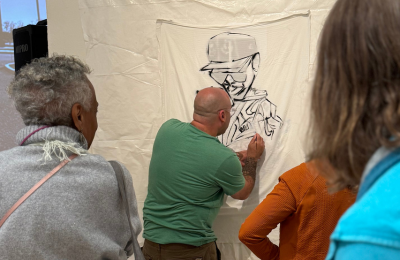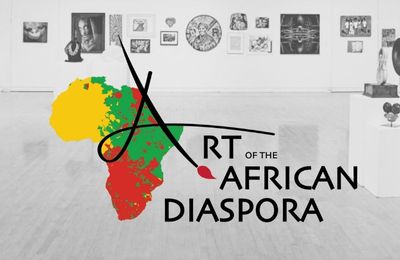Mission Local: Who is Emmy Lou Packard?
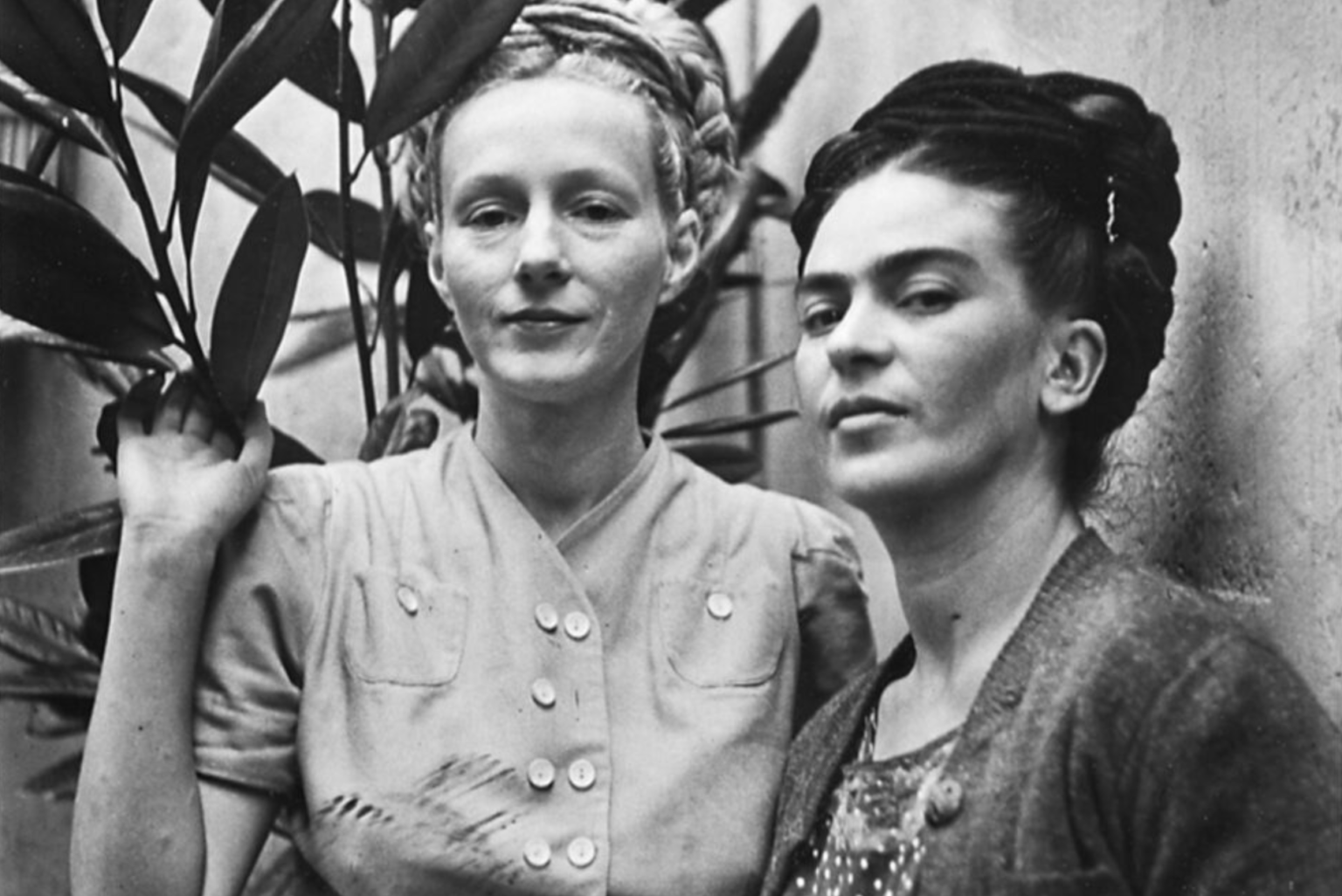
Mission Local: Who is Emmy Lou Packard?
By Carolyn Stein
July 28, 2022
Link: https://missionlocal.org/2022/07/who-is-emmy-lou-packard/
If people are familiar with the name Emmy Lou Packard, it is mostly because of her long alliance with the Mexican muralist Diego Rivera and his wife Frida Kahlo.
Indeed, “Emmy Lou Packard: Artist of Consciences,” an exhibit that opened on June 18 at the Richmond Arts Center – her first show since her death in 1998 – was timed to appear with the San Francisco Museum of Modern Art’s recently opened exhibit on Diego Rivera.
But what’s clear from the Richmond exhibit – open at the Richmond Arts Center until August 20 – is that Packard produced a wealth of work apart from her role as Rivera’s assistant. The show of linoleum prints, photographs of murals she did on her own and some paintings, illustrate a reach far beyond her association with Rivera.
But, unlike the Mexican muralist, Packard shied away from press and self-promotion.
It’s work defined by a simplicity that captures the quotidian. In one linoleum print a man stands in an overgrown artichoke field. His hat covers his eyes as he picks the prickly bud from its stem. The field closes in on him. All sense of time is lost.
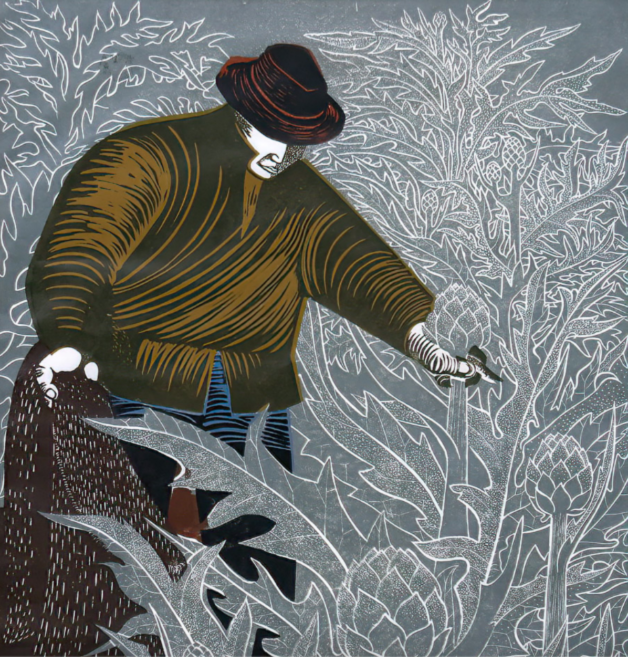
“She had a personality, but it wasn’t about her,” said Packard’s former student and documentary filmmaker Rick Tejada-Flores in comparing her to the larger than life figure of Rivera. For Packard, he said, “It was about her work and what she wanted her work to do.”
Tejada-Flores co-curated the exhibit with artist and author Robbin Légère Henderson, who grew up with one of Emmy Lou Packard’s prints in her home.
Although Packard, who died in 1998 at age 83, had displayed her work in galleries, she was more concerned with making her art accessible to a wider audience, Tejada-Flores said.
“There’s a guy in Davis who knew Emmy Lou quite well toward the end of her life. And she was not making art. She was in a nursing home. … So he said, ‘Well, Emmy Lou, let’s do a show of your work.’ And she said, ‘You can do it after I die,’” Tejada-Flores recalled.
While Packard has largely been forgotten except for the time she spent with Rivera, she has always had a strong following among artists in the Mission and in 1973 advised the trio of young artists who painted a mural at the Bank of America at 23rd and Mission streets.
“She’s an unsung heroine in the arts,” said Mission District muralist Juana Alicia Araiza. “I knew her until the end of her life … she gave me one of her prints as a wedding present.”
Others credit Packard with promoting Mission District artists. “I feel like Emmy Lou Packard was one of the first to fight for the Latino District and brought awareness to the art in the Latino District,” said Mission-raised artist and activist Lucia Gonzalez Ippolito.
An Artist of Social Consciousness meets Diego Rivera
Packard was born on April 15, 1914 in El Centro, in California’s Imperial Valley. Her lineage can be traced back to County Carlow, Ireland – where her great-grandfather was a bearer of dispatches in the Irish Rebellion. From childhood, Packard was surrounded by family conversations on communism and socialism.
“I had not read Marxism (not until I was 25). But my father’s explanation that ‘capitalism fosters war, socialism suffers as a result of war’ kind of stuck with me as a guiding principle,” Packard explained in her oral history interview with Louise Gilbert.
In the 1920s, Packard and her family traveled to Mexico City; in November 1928, Packard’s mother introduced Rivera to her young daughter, kickstarting Packard’s career under one of the great Mexican muralists. Every other week, Rivera would meet with Packard to give her art critiques.
“I was surprised at the great character, the sensitivity of tones and the objective and subjective truth of the paintings of Mexican life that this North American child had done,” Rivera once said of Packard. “She was a blonde, melancholy little girl. With the face of a French gothic angel plucked from the reliefs of Chartres. … Embarrassed and shy, bright and a little savage, she had all the character of the country in which she was born.”
Packard eventually moved back to the United States and went on to study at the University of California, Berkeley. She reunited with Rivera in 1940 when the great Mexican muralist asked Packard to be his chief assistant on the Pan American Unity mural, which is currently on display at the SF MoMa. It is a sprawling vision of cultural unity in North America in which Packard appears on the left side standing just above Charlie Chaplin.
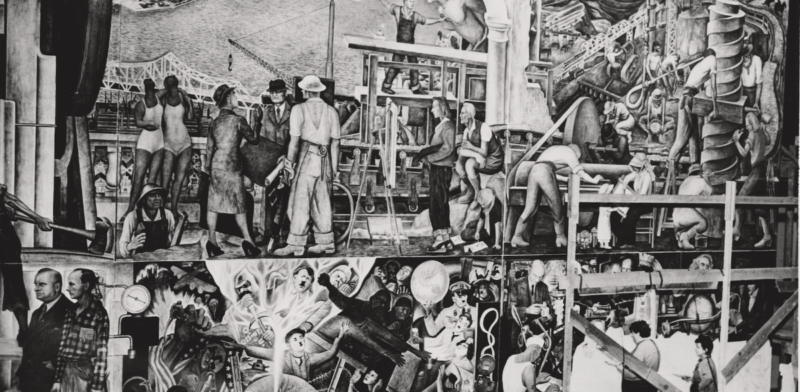
Once the mural was finished, Packard returned to Mexico to live with Rivera and Kahlo, where she deepened her friendship with the two artists. In 1941, Kahlo and Rivera would help Packard open her first one-woman show.
Rivera once said that “[a]ll art is propaganda” and art was his weapon. For Packard, art served a similar function, but her images weren’t as overtly political as Rivera’s. “She was able to say complex things with simple, solid images,” Mission District artist Miranda Bergman said.
When Packard moved to San Francisco in 1941, World War II was at the forefront of the world’s mind and guided much of Packard’s artistic and political work during this time. She painted for an exhibit that highlighted the extra burden women faced during the war, created art on the history of union movements for the California Labor School and joined the staff of the Kaiser shipyard paper Fore ‘n Aft.
“My first trip out to the Richmond shipyards was in the early evening, and I still remember the excitement of the big yards working at night.” Packard recalled in her oral history interview.
There she found all classes of Americans that she later described in the oral history as Americans “united and enthusiastically engaged in a struggle to end fascism in Europe.” Packard created hundreds of drawings and cartoons of the people in the shipyards for Fore ‘n Aft, some of which are installed in the Richmond show.
But much of the Richmond show focuses on the linoleum prints that Packard began making in the 1950s. She liked the medium because ordinary people could afford the cheap prints.
“When I think of Emmy Lou, right away, an image comes to mind of a merry-go-round,” Bergman said, referring to one of Packard’s prints of children on a merry-go-round. “The print has been in my home ever since I was born. It imagined a future of racial unity and showed children of all colors playing on the merry-go-round. She was visionary in terms of imagining a future of peace and unity.”
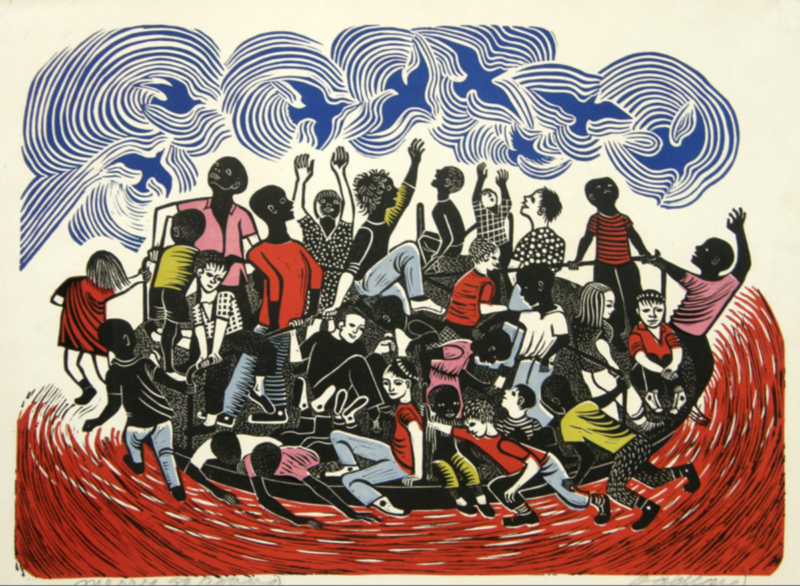
Packard’s work circulated far beyond the Bay, with pieces reprinted in other countries like the Soviet Union. “Her art represented her heart, her beliefs,” Bergman said.
But not everyone was on board with Packard’s left-leaning beliefs.
“One morning, at 11, there was a knock on my door, and when I opened the door two men in gray suits were there,” Packard recalled in her oral history interview. The two men were from the FBI and asserted that they had “absolute proof” that Packard was a communist, to which Packard responded that the two men had “no such proof.”
“Have you ever read Karl Marx?” the two men in suits asked Packard.
“Of course. I took economic history at UC [Berkeley]. Marx is part of economic history,” Packard said.
“Did you UNDERSTAND it?”
“Of course. Haven’t you ever read it?”
“WE’LL ask the questions!”
Packard and Nature
Another portion of the Richmond show’s prints come from those she made after moving to Mendocino in 1959. The prints focus on the sprawling sea life and water towers of the area.
Packard’s strong interest in Mendocino’s nature also made her an advocate in opposing construction that would disrupt the area’s coastal bluffs. Her organizing efforts were successful and led to the creation of the Mendocino Headlands State Park, where there is a plaque that honors her efforts to save the coastal bluffs.
“People didn’t appreciate [the bluffs] until it was in danger of being lost,” Tejada-Flores explained.

Finding Packard in the Mission
After spending 14 years in Mendocino, Packard returned to San Francisco in 1973 and began to help with the Bank of America mural.
“She didn’t pick up a brush, but she would come over and correct our brushstrokes,” Rios recalled. “We were very fortunate to have her as a technical advisor. She also took us over to City College to show us her role in working on the Pan-American Unity Mural.”
Elaine Chu, co-founder of Twin Walls Murals Company, discovered Packard’s blocks for print-making one day at Precita Eyes Murals on 24th Street. Chu was working under Precita’s founder Susan Cervantes at the time, who explained to Chu the strong relationship she had with Packard.
“She really supported community murals because she saw the beauty of the community in the Mission,” Chu explained. “There is a very rich history that Emmy helped foster.”
Bergman echoed Chu’s sentiment.
“I think about her as an elder artist too because she kept going until she couldn’t,” Bergman said. “I’d do anything to make people familiar with her work because it’s resonant with today…the struggles for peace as a human right.”
CAROLYN STEIN: Intern reporter. Carolyn grew up in Los Angeles. She previously served as a desk editor for her college newspaper The Stanford Daily. When she’s not reporting, you can find her going on an unnecessarily long walk.
Top image: Emmy Lou Packard poses for a photo with Frida Kahlo. The two artists had a strong relationship. Photo Courtesy of Rick Tejada-Flores.
Tags: featured


